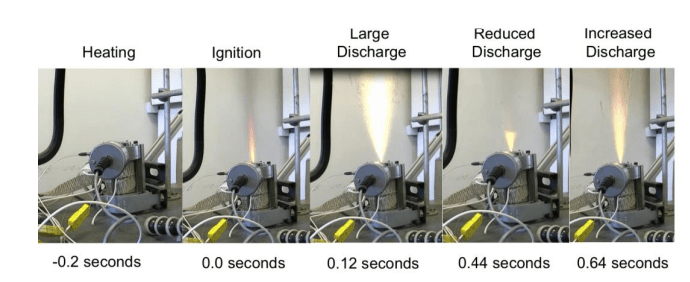A few years ago, there was a panic about lithium-ion batteries that exploded and could do things like take down a jetliner. On a recent trip, an airline asked passengers to turn in any devices with batteries that had been banned because of safety concerns. These are indicators of a widely understood downside of lithium-ion batteries, ubiquitous in cell phones, laptops, and other electronic hardware – they can easily catch fire very spectacularly. However, a team at the Aerospace Company is working on an idea to turn this potentially catastrophic event into an asset – by using it to deorbit defunct satellites.
Almost all satellites have some form of battery backup in them. Many utilize it to keep the lights on, while its solar panels aren’t catching enough rays to fully power the craft. And most of those batteries are some form of lithium-ion, so the industry already widely adopted the underlying technology.
But the satellite industry has to deal with an ever-increasing number of pieces of debris floating in or near low Earth orbit (LEO). Some will never deorbit and burn up in the atmosphere by themselves.
We need a solution to space junk, as Fraser explains.We’ve reported on plenty of strategies to deal with this problem before. From satellites that will specifically couple with other satellites and force them into a deorbiting path to nets that would slow a satellite down to a point where it would reenter on its own, they all have pros and cons.
But with this new idea, called the Lithium Ion Battery Deorbiter (LiBDO) by its creators, there wouldn’t be any external hardware involved at all. There could simply be a minor adjustment to the battery pack itself, with almost no extra weight – an essential calculation for spacecraft designers.
The idea is simple enough. LiBDO batteries would be designed intentionally to puncture the battery and use the resulting plume of hot gases as a thruster. Joseph Nemanick and his colleagues at the Aerospace Corporation did some testing to see what kind of thrust could be expected – they calculated that, in a vacuum, a single battery cell being punctured would result in about 29.3 N of thrust.
 Testing shows how a punctured battery could act very much like a thruster.
Testing shows how a punctured battery could act very much like a thruster.Credit – Nemanick et al.
That might not seem like much compared to the thousands of Newtons provided by some rocket engines, but it could significantly decrease the time a defunct satellite stays in orbit. By one calculation, a single battery cell being punctured could reduce a satellite’s deorbit time by up to 55%.
Any decrease in that time is welcome when the object is trying to avoid being hit by other debris in its orbit. Notably, the researchers calculated that the debris such a puncturing itself might create is minimal – only about 50 micrograms of material, hardly enough to damage anything, and it might just end up being deorbited itself soon as well.
How soon the technology might be adopted, if it is adopted at all, remains a mystery. While a preliminary test presentation is hosted on a NASA site, it’s unclear what, if any, support the project is currently receiving. But, using a potentially catastrophic weakness of lithium-ion batteries as a tool is an extraordinarily unique way to solve what will become an increasingly pressing problem as we continue to launch more and more stuff into orbit.
Learn More:
Nemanick et al – LiBDO : The Lithium Ion Battery Deorbiter
UT – A New Mission Will Grab Dead Satellites and Push Them Into the Atmosphere to Burn Up
UT – Companies Will Have Five Years to Dispose of Their Dead Satellites
UT – We Need to Fix Space Junk Before It’s Too Late

